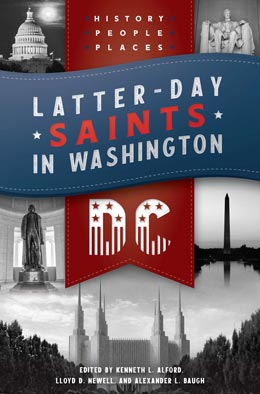Introduction
The Church of Jesus Christ of Latter-day Saints has an important history in Washington, DC. Beyond cities like Salt Lake City, Logan, and St. George in its traditional western footprint, or communities like Palmyra, Kirtland, and Nauvoo that were central to its founding narrative, no U.S. city has had a more significant influence across the history of the Church than the nation’s capital. The Church’s presence in the District of Columbia spans nearly the entirety of the faith’s history. Significant influence exerted on the Church by individuals and agencies associated with the federal government make a study of the Church in Washington, DC, a rich endeavor.
As early as August 1833, Latter-day Saints were directed “in befriending . . . the constitutional law of the land” (Doctrine and Covenants 98:6). Responding to growing violence in Missouri, the Lord instructed Saints to “continue to importune for redress, and redemption, by the hands of those who are placed as rulers and are in authority over you,” including the governor and the president of the United States (Doctrine and Covenants 101:76; see also v. 88). Following the Prophet’s release from Liberty Jail, Joseph Smith visited Washington, DC, in the winter of 1839–40, seeking redress for the Saints’ suffering in Missouri. Later, a revelation directed that a proclamation be written “to the honorable president-elect,” calling upon him and other leaders of nations “to give heed to the light and glory of Zion” by coming “with your gold and your silver, to the help of my people” (Doctrine and Covenants 124:3, 6, 11).
From those earliest interactions with the federal government, the story of the Church has been shaped by leaders and members interacting in Washington, DC. In 2019 the faculty of the Department of Church History and Doctrine at Brigham Young University traveled to DC to study the intersection between the nation’s history and the Church and hosted a symposium in the Washington D.C. Temple Visitors’ Center, visiting archives, historic sites, relevant museums, and networking with local members, historians, and dignitaries. This volume is filled with essays representing some of the many topics explored during their regional studies.
The book is divided into three sections. The first section, “History,” examines episodes occurring in or involving Washington, DC, including Joseph Smith’s 1839–40 visit, Latter-day Saints petitioning for redress, the federal government’s role in Latter-day Saints fleeing persecution, and Orson Pratt’s publishing of The Seer. In the twentieth century, it recounts the placement of a Nauvoo Sunstone in the Smithsonian Institution, participation by the Tabernacle Choir at Temple Square in national celebrations, the development of the proclamation on the family, and ways Latter-day Saints have been characterized on the pages of the Washington Post.
The next section, “People,” details prominent individuals affiliated in a variety of ways with Latter-day Saints in the District of Columbia. Included are elected officials like Senators Reed Smoot, Elbert D. Thomas, and President Theodore Roosevelt; cabinet secretaries Ezra Taft Benson and T. H. Bell; public affairs director Beverly Campbell; the Marriott family; and dedicated Church leaders who provided leadership as Church membership began to increase in the DC area. Through the lives of these men and women, Latter-day Saint life in the DC area is examined, especially across the twentieth century.
The final section, “Places,” begins with an examination of how Joseph Smith’s portrait came to be placed in the National Portrait Gallery. It explores prominent sites associated with Latter-day Saints in the DC area, including the Washington Chapel and the temple, as well as Latter-day Saints interred in Arlington National Cemetery. It also considers the influence of federal agencies like the National Park Service who extend their reach beyond Washington to influence Latter-day Saint historic sites across the country and concludes with an annotated photo essay of historic sites in Washington.
Latter-day Saints in Washington, DC helps readers appreciate the sometimes complicated, yet cooperative, relationship between the Church and the United States federal government. It chronicles Saints and statesmen who have worked to bring the Church out of obscurity and onto both a national and international stage. We hope you enjoy this volume!
